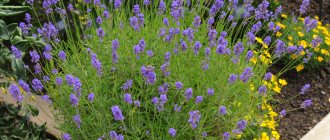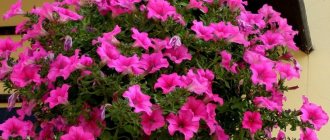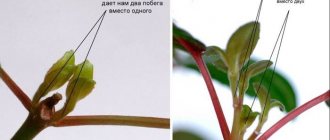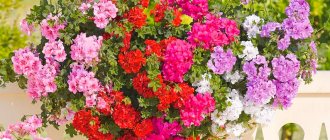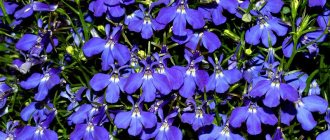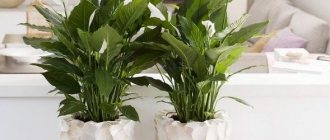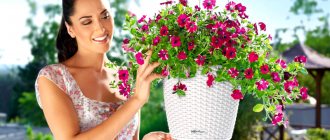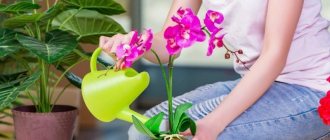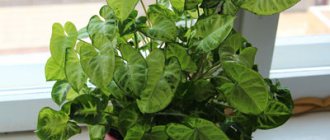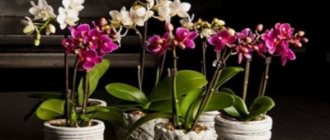What types of flowers are there to grow in pots?
Landscape designers and experienced housewives often create incredible color compositions in the courtyard of a house or cottage. To make a hanging garden look beautiful, you need to know what types of flowers are suitable for this purpose and how to properly care for them.
Ampelous flowers
There are several types of plants for growing in hanging containers:
- curly;
- creeping;
- multi-socket;
- blooming;
- succulents;
- decorative deciduous;
- creeping.
Flowering plants
Flowering ampels include:
- petunia;
- begonia;
- lobelia;
- viola;
- fuchsia;
- diascia;
- catharanthus;
- verbena.
Flowering plants for pots
Resistant to direct sunlight
Most hanging plants for pots tolerate sun well. But still, it is better to place the flower pot so that the midday sun does not fall on it.
Plants that are not at all afraid of sunlight:
- petunia;
- verbena;
- bidens;
- Moorish bindweed.
Important! It is necessary to provide these plants with frequent watering on hot days, in the morning and evening.
Wind resistant
Hanging outdoor flowers for pots are quite resistant to winds. But during severe bad weather, it is better to put them indoors. Pots with flowers should be placed in a place where there are no constant drafts.
Hanging spurge is considered the most resistant to strong winds.
Flowerpots
Ampelous annuals
There is a wide range of plants that can be grown in pots.
In addition to the common and beloved petunias, pelargoniums, verbena, lobelia, and nasturtium, there are also unfamiliar hanging plants. There are annuals that have increased resistance to growing in the sun, and there are those that tolerate shade or partial shade.
In addition, the soil in hanging pots dries out quickly; in hot summers you have to water them twice a day. If this is not possible, it is advisable to select plants that do not require frequent watering and that can tolerate short-term drying out of the earthen clod.
Baskets with shade-tolerant annuals can be successfully hung on trees, in shady places in the garden, on the east or north side of the house.
The flowerpot is taken outside only after stable heat has been established, and before that it can be temporarily placed in the house.
What indicators should you consider when choosing the plants you will grow?
- the place where the flowerpot will hang - shade, partial shade or direct sunlight;
- frequency of watering plants, if you cannot water every day, and some flowers even twice a day, it is better to choose drought-resistant plants;
- the plant's tolerance to strong winds, because it also dries out the soil and can break off flower branches;
- in the gazebo or on the veranda there is usually a draft, which most plants cannot tolerate;
Recommended annuals for sunny side:
- viola or pansy, but flowering in the sun is more abundant and bright;
- Waller's balsam /Impatiens walleriana/;
- prostrate nolana /Nolana prostrata/ and strange nolana /Nolana paradoxa/
Flowers that tolerate wind well:
- hybrid ampelous petunia – surfinia /Surfinia/;
- Scaevola aemula/;
- Sanvitalia
- fortune;
- Diascia /Diascia/;
- Euphorbia “Diamond Frost”;
- nemesia /Nemesia/.
Moisture-loving plants:
Drought-resistant plants:
- bidens or ferulifolia series /Bidens ferulifolia/;
- verbena /Verbena/;
- lavatera ampelous;
- osteospermum or Cape daisy /Osteospermum/;
- ampelous ivy-leaved pelargonium;
- Euphorbia “Diamond Frost” /Diamond Frost/.
Plants that can easily withstand rain:
Plants that need slightly acidic soil:
Plants that prefer alkaline soils:
Choose your plants, depending on where the baskets with them will hang and which side of the world your balcony faces.
Do not throw away the seed packets so that later, when planting seedlings in containers, you can select plants based on the colors of foliage and flowers.
Flowers that love sun and shade, are drought-resistant and moisture-loving cannot be planted in one basket.
Before sowing annuals, it is necessary to prepare the soil. If there are no special recommendations, choose a universal soil, but it must be loose, light, well-drained; the easiest way to do this is to add sand.
It is advisable to spill the soil in containers with a weak solution of potassium permanganate or boiling water, or even better, steam it in a water bath. Before sowing, the soil should dry out slightly.
If the seeds are very small, they are first mixed with sand and then sown without covering them with soil. Lightly moisten with a spray bottle. The top of the container is covered with glass or polyethylene. To avoid the appearance of fungus, the container must be ventilated every day. The soil should be slightly moist, but not wet. By over-moistening the soil, you interfere with the access of oxygen, which seedlings need no less than moisture.
After germination, the glass is removed. When the first true leaves appear on the plants, they are picked into separate cups or directly into containers.
For abundant flowering, plants are fed at the seedling stage.
By choosing the right plants, you can create a variety of abundantly flowering hanging baskets on your own, without large material costs.
Attention! The article is updated all the time, new plants are added.
The best flowers for the garden
Ampelous petunia - growing in hanging pots
To create a beautiful flower arrangement for the garden, the following flowers are suitable:
- rose;
- carnation;
- cottonweed;
- hibiscus;
- cosmos;
- morning glory;
- gaillardia;
- gazania;
- veronica.
Imopoeia seeds
Growing hanging flowers for the garden
To make the ampels in the garden look beautiful, you need to know the peculiarities of their planting and choose the right place for each type of plant. It is also necessary to know how to care for them: water, fertilize, propagate, prune, replant.
Important! You should choose the right container for each plant and the right soil.
Hanging Garden
Selecting a location
Hanging gardens should be planned in open areas so that the sun's rays illuminate them all day long. Then the flowering bushes will be lush and beautiful. There is no need to place the ampels in drafts, as in this case they may die.
Flowerpot plants should be planted in the evening or on a cloudy day. Then they will be well accepted and grow.
The soil for these flowers should be loose and breathable. You can mix peat and regular soil in different proportions and add a little sand.
For lush flowering, you need to fertilize the soil once every 10 days with universal products. Watering should be abundant and regular. On hot days you need to water twice a day, on cool days - once a day.
For your information! You can order seedlings and delivery of hanging flowers on the Internet. Along with the flower will come a detailed description of the features of caring for it.
What varieties of hanging trees are best to plant on the site?
Let's look at some garden hanging plants that bloom beautifully and are easy to care for.
Option #1 – hanging begonia
A wonderful plant with small scarlet or bright red flowers on delicate, flexible and long stems. The flowers resemble small chrysanthemums. This is a rather whimsical plant that does not tolerate heat at all and needs frequent watering. Begonia should not be placed in bright sun; you need to choose a shaded corner for it. If summers are too hot in your area, this plant will not be suitable for the garden.
If the ampelous begonia feels good in your garden, it will delight you with abundant flowering. Even one pot with such a beauty will decorate a gazebo, veranda or terrace. Try to keep the plant out of direct sunlight
Option #2 – pelargonium
One of the most unpretentious plants is pelargonium (or geranium). Geranium loves the sun, warmth, and is not afraid of drought. The plant will not disappear if you are away for a long time and there is no one to water it.
There are many types of pelargonium that grow well outdoors and indoors. Boxes with blooming pelargonium can be placed in any sunny place in the garden, under the windows. This plant also looks good in flower beds
Option #3 – lobelia
Lobelia is a hanging plant that is also well suited for the garden; it can grow in both sun and slightly shaded areas. Lobelia should grow in moist, humus-rich soil.
Using lobelia you can make a kind of “edging” for some garden buildings, or, for example, a fence
Option #4 – ampelous petunia
Ampelous petunia is known to everyone. Its bright, beautiful flowers of purple, lilac and red colors can be found in summer not only in gardens, but also as decoration for city balconies and cafe terraces. Petunia needs regular watering, a well-lit, warm place and fertile soil. It will delight you with its flowering until the onset of cold weather.
An option for decorating a path using a hanging petunia. Such two-tier pots on beautiful wrought iron stands are sold in flower shops, and the colorful flowers in them look simply luxurious
Option #5 – bacopa
Bacopa is a perennial, but in our country it is more often used as an annual plant. Blooms throughout the warm period, grows in sun or partial shade. The soil should be watered moderately so that it does not dry out or become overly moist.
Bacopa is known for its ease of care. There are varieties with white flowers - as in this photo, as well as with lilac and violet colors
Flowering hanging plants are, of course, favorites among those who like to decorate their garden. But there are also non-flowering varieties of ampels that can transform any unremarkable or even dull place into a pleasant place to relax.
Option #6 – dichondra
Ampelous dichondra is a new product in our flower market. This is a deciduous plant whose shoots can reach one and a half meters in length. Dichondra leaves are small and round in shape. May be green or silver. The plant is perfect for both vertical gardening and for creating a carpet on the ground.
This is the kind of carpet that dichondra can form on the ground. You can place the shoots symmetrically, directing them along the tile line
Dichondra, hanging from a flowerpot, looks quite unusual. This cascade of green or silver lush greenery will add charm to any space in the garden.
There are many types of hanging plants, this is only a small part of them. All of the above plants grow well in our gardens, they do not require special care, but turning the site into a wonderful corner with their help is not at all difficult
You just need to pay attention to them, care for them, and water them in a timely manner.
Ampelous flowers for pots hanging in the apartment
The most popular hanging indoor plants are:
- Wood's Ceropegia. It has light red and dark green leaves with white stripes.
- Chlorophytum. It is often called the green lily. It grows and develops well even in dark rooms. It is usually placed in the kitchen or in places where there are a large number of people, as the plant perfectly purifies the air.
- Dichondra. Excellent for hanging baskets and does not require special care.
Ampelous petunia - growing in pots and care
There are a huge number of hanging plants that can be used to decorate a house or apartment in hanging containers. The most popular are fuchsia and begonia.
Fuchsia ampelous
Belongs to the fireweed family and comes in different varieties. This climbing plant should only be planted in flowerpots; in ordinary pots it will not be able to show all its beauty.
Fuchsia varieties:
- Golden marinka - elongated flowers with a white center, light green leaves have a golden tint.
- Icicle has large white flowers, sometimes with a pink tint.
- First love - flowers are presented in purple colors from light to dark.
- Fairy – white and red flowers.
- Golden Monica - large double flowers of a pink hue.
- La fiesta - bright crimson flowers with light sepals.
Fuchsia should be placed in partial shade so that the midday sun does not hit the plant. The pot should be small. The soil is universal. In the warm season, fuchsia can be kept outside or on the balcony, in winter - in a warm room.
Important! At the beginning of spring, the plant should be transplanted into a larger pot.
Begonia: variety of forms and types
Begonia is an unpretentious plant that has beautiful bright flowers up to 8 cm in diameter, asymmetrical leaves, and a beautiful bush shape. Petals can be double or single. The color scheme is represented by all shades of red, and also comes in white, orange and yellow.
The pot for begonia seedlings should be shallow and wide, and there should be a drainage layer at the bottom. The plant should be planted in partial shade so that at noon it is in the shade.
Compositions
You don't need to be a designer to create a beautiful composition. The main thing is to choose the right varieties. Plants should complement each other. Compositions can be different: from a simple combination of different colors to professional selection. For example, you can plant yellow, red or orange petunias in one pot.
Composition of creeping
In general, hanging plants have many colors. The main thing to remember is that the plantings should be of the same height so as not to shade each other.
In open soil, you can create a picture with the help of ampelous outdoor plants. Suitable creeping plants that cover the soil include:
- Monkey loosestrife is a perennial plant that grows quickly as the weather warms up, covering the flower bed. The leaves are round, the flowers are small yellow, they can climb up and decorate the wall with their greenery;
- Lesser periwinkle is also a perennial, which in the spring will decorate its lush green shoots with purple flowers;
- dichondra will cover the carpet with long shoots and decorate the flowerbed.
Note! Old things that can be given a second life are suitable for decorating the garden as pots and flowerpots. These could be old carts, barrels, baskets, shoes
For a dacha, hanging plants can decorate not only the site, but also braid a fence, a gazebo, and small structures (shower, cellar, outbuildings).
Even just placing pots along the path will become a decoration and will lift the spirits of both guests and owners
For your information! The more care and attention is invested at the beginning of a flower’s growth, the brighter and longer it will delight its gardener.
Contrasting combinations
For mixed compositions, you can combine different flowers, or you can plant the same type of different flowers. Pelargonium, petunia, nasturtium, fuchsia, and verbena will be excellent neighbors. They feel great in the company of other plant species. When creating a composition, you can play with:
- in color, choosing contrasts: white petunia and red pelargonium, blue lobelia and yellow begonia, fuchsia and white bacopa;
- in tiers. You can decorate the wall in tiers with colored balls. In such single pots, petunia, bacopa, lobelia, bidens will bloom in a spherical manner;
- shape and height. For example, dichondra, whose lashes will hang down, fits perfectly next to petunia. Fuchsia flowers fall down, and nasturtium may appear in the center.
Tiers in one pot
Almost all types of hanging plants are suitable for creating hanging gardens; the main thing is to remember that the smaller the pot, the more often the plant requires watering. Easy-to-care, hanging flowers for the garden will lift your spirits until the coldest weather.
Shade-loving hanging plants for pots
Plants for pots that grow well in the shade can be placed on terraces and in gazebos. You can decorate arches and other poorly lit places with them. These include, first of all, begonia and sorrel.
Where are ampelous plants used?
Hydrangeas in landscape design - what plants go with in the flowerbed
Pots with hanging flowers can be used both indoors and in the yard. There are plants that are suitable for both indoors and outdoors. Are there only indoor or only outdoor plants? To ensure that the efforts and money spent on flowers are not wasted, you need to familiarize yourself with the different varieties of hanging plants, the features of caring for them and methods of propagation.
Placement of hanging gardens
When designing a hanging garden, you need to choose the right containers for planting. They must be in the same style and match the exterior. The composition should be in the same color scheme or the colors should harmoniously complement each other.
An overabundance of plants will not be a good option for decorating a garden or yard, just as too few will be lost against the backdrop of a large area.
Important! Flower arrangements must be well-groomed. Limp, small, dried parts should be removed in time so as not to spoil the composition.
Petunia: a wonderful fragrant flower for pots
Petunia grows well in a hanging pot and blooms for several months. She is unpretentious in care. This is one of the most popular hanging plants for outdoor pots.
Ampelous petunia
Ampelous bacopa: a charming flower
Bacopa is a beautiful perennial plant belonging to the Norica family. This creeping plant comes from South Africa; it has been popular in Russia for about 20 years. However, in cold winter conditions it does not survive to the next spring and is considered an annual. If the plant is removed in the cold season to a house where the temperature does not drop below 10 degrees, then in the spring it will bloom again.
Bacopa
Long shoots reach 70 cm, small leaves are arranged in pairs and have an olive tint. Small flowers are densely located on the bush and come in blue, white, pink and purple. Flowering occurs in waves.
Bacopa does not require special care. The main thing is not to forget to water the plant regularly, since in nature it grows near bodies of water.
You need to plant the flower in a well-lit area, then the bush will be lush and bright. In shaded areas it will have very small flowers and the shoots will become thin and long. Regular pinching of young shoots will increase the volume of the bush and the splendor of the flowers.
Important! When planting bacopa in a pot, you need to ensure good drainage at the bottom of the container.
Examples of decorating a garden using hanging
The beauty of ampels is that they are easy to grow, or you don’t even have to grow them yourself, but buy already flowering plants in pots, or buy beautiful decorative pots and transplant seedlings into them - petunia, pelargonium, fuchsia, begonia.
A beautiful wall of hanging plants arranged in several tiers
Garden composition of hanging lamps in country style. If there is no cart, you can use a decorative well, wattle fence
By placing ampels near the walls, you can create a cozy small courtyard
With the help of hanging plants you can beautifully decorate your patio, gazebo, or terrace. They will look good placed in tubs along garden paths. A beautiful combination can be formed by hanging plants and vines. Lianas can twine around a fence, the wall of a house or other building and serve as a spectacular green background for ampels. If you don't have enough time to grow plants in your garden, decorate your garden with hanging plants, placing them in hanging pots and outdoor decorative planters throughout and you will see that your garden will turn into a paradise.
Advantages of hanging gardens of annual flowers
One of the main advantages of hanging gardens is their durability. Most types of hanging plants bloom in late autumn. Some of them can overwinter in a warm room and bloom again in the spring. They can be propagated in different ways.
Hanging plants save garden space. They can be placed in a small yard, made into stylish compositions, or combined with small pools or ponds. If there is no yard at all, then hanging plants in pots can be an excellent decoration for a terrace, gazebo, balcony or windowsill.
Pots with bright flowers look beautiful from any angle
Any flowers decorate and enliven the place where they are located. Ampelous flowers in pots make it possible to create original, unique compositions that can please the eye throughout the summer and even in winter.
For the balcony
If you choose for a balcony, you need to consider which side it is on. After all, there are plants that love the sun, while others can only grow in the shade. You can even grow strawberries and wild strawberries on the balcony, but you need to carefully care for them, then they will delight you not only with their beauty, but also bring a good harvest.
Balcony decorated with petunia
After choosing the type, you need to take care of the decoration option for the balcony or loggia. It looks very beautiful when a bright hanging form grows in the center of the balcony, and curly ones hang along the edges.
For an apartment you should choose the following varieties:
- fuchsia. Her two-color bells will be able to decorate the balcony until frost;
- ivy. Looks very original in a flowerpot. This unpretentious vine can grow even in shady places;
- purslane. Another unpretentious plant. He is not afraid of rain and sun. There are varieties that close their flowers during rain, but in sunny weather they delight with their varied colors;
- Cyclamen feels good both indoors and on the balcony. The main thing is to water on time.
Composition for the balcony
Ampelous flowering plants are very beautiful and unpretentious. They look stunning in the garden and in planters on the veranda. In winter they can decorate your house and balcony. The importance of an ampel flower in landscape design is enormous. Ampelous - what does it mean? This means beauty, because climbing plants look very beautiful and are suitable for any composition. You can easily grow them yourself or buy them already blooming.
It doesn’t matter what flowers will decorate the garden or balcony, the main thing is that you need to love them. Under these conditions, violas and petunias will delight with their beauty for a very long time
Advantages
The advantages of designing a site using ampels are obvious:
Mobility. Flowerpots and other hanging containers can be easily swapped, creating new compositions each time and constantly maintaining a sense of novelty.
Versatility. You can decorate anything with hanging flower arrangements - a gray, nondescript wall, a modest terrace, a gazebo in the yard, and even vegetable beds. You can hang the pots on a stand dug into the ground or place them on an old, outdated barrel or cart.
Easy care. They do not require anything other than regular watering and occasional feeding. They grow like ordinary indoor house flowers.
Functionality. They can cover unsightly places, ugly structural elements, etc. In winter, they will become a chic addition to your home interior, insulated loggia, or winter garden.
Economy of accommodation. When suspended, they do not require additional space.
Visibility. A hanging flower bed is equally visible from almost any angle.
And, of course, decorativeness
They attract attention, create coziness, create an accent in the intended place, and complete the overall landscape idea.
Ampelous lobelia: an undemanding perennial
Lobelia (lat. Lobelia) is an undemanding annual that requires growing in a sunny place. The plant has many small flowers, the length of the shoots reaches 0.5 m. Lobelia blooms all summer and autumn. The color of the flowers can be blue, purple, red. Lobelia is propagated mainly by seeds.
The most popular variety Diascia (lat. Diascia) is a hanging plant, ideal for terraces. The soil for lobelia should be fertile, watering should be good, but waterlogging should not be allowed. Diascia blooms from summer to October. Propagation is carried out by cuttings and using seeds.
Lobelia (lat. Lobelia) is an undemanding annual that requires growing in a sunny place
Features of growing such plants
Containers and flowerpots are convenient because they can be placed in almost any part of the garden or local area: along the edges of benches, at the entrance to the house, around the pool, along paths. If necessary, it is possible to rearrange the plants, replace them with others, and for this you do not need to dig up the bed or create a new flowerbed.
Various compositions of flowers in flowerpots look great in a cascade version: for this, create several levels of the same or different flower pots and plant flowers that are contrasting in shade or size. Shelves, steps, hanging structures, and stands are suitable for decoration.
Plants that live in confined spaces are somewhat different from flowers intended for planting in the ground. The differences relate to the following points:
- the root system of flowers feels great in a small space;
- plants are hardy and tolerate drought or excessive moisture;
- as a rule, flowering continues throughout the season - new buds grow to replace faded flowers;
- The bushy or trailing form of the plants is ideal for planting in pots, plant pots, flowerpots or containers.
Minimal flower care is another plus in favor of outdoor flowers.
